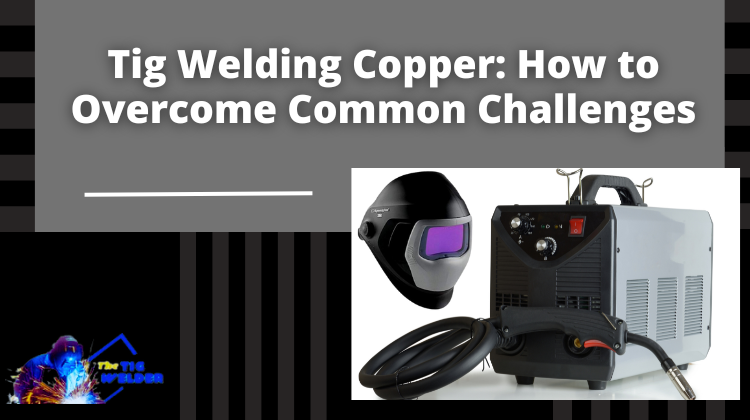Tig welding, also known as gas tungsten arc welding, is a welding process that uses a non-consumable tungsten electrode to produce the weld. It is highly prized for its ability to produce high-quality, precise welds with minimal spatter and distortion. On the other hand, copper is a highly conductive and malleable metal widely used in various applications, including electrical wiring and components, plumbing, and heat exchangers. However, welding copper can be challenging due to its high thermal conductivity, leading to warping and distortion if not properly controlled. This article will discuss the steps and techniques involved in tig welding copper, common challenges, and how to overcome them.

How to Overcome Common Challenges
Tig welding copper can present some unique challenges, such as the high thermal conductivity of copper and its tendency to form oxides on the surface. These challenges can be overcome by using the proper welding techniques and equipment and following best practices for preparing the copper for welding.
Some common challenges that may be encountered when tig welding copper include:
- Getting the right amperage
- Maintaining a clean and stable arc
- Avoiding contamination of the weld joint
By taking the time to properly set up and prepare for the welding process, it is possible to achieve strong, high-quality welds on copper.
Pre-weld Preparation
Before you start tig welding copper, it is important to properly prepare the materials and equipment. First, clean and dry the copper surfaces to be welded to ensure that there are no dirt, oil, or other contaminants that could affect the quality of the weld. You can use a wire brush, sandpaper, or a chemical cleaner to remove any dirt or oxide build-up. Next, choose the right tungsten electrode based on the thickness and type of copper you are welding. For example, a 2% thoriated tungsten electrode is typically used for welding thin copper sheets, while a pure tungsten electrode is suitable for thicker sheets.
It is also important to set the correct amperage for the weld. Too low of amperage can result in a cold or incomplete weld, while too high can cause excessive heat and warping. The proper amperage can vary depending on the thickness and type of copper, as well as the size of the tungsten electrode. A good starting point is to set the amperage at around 50-70% of the rated output of the welding machine for copper sheets up to 1/8 inch thick.
Welding Techniques
Once the materials and equipment are prepared, it’s time to start welding. When welding copper, it is important to use the right technique to ensure a strong and consistent weld bead. One technique is to use a push or pull motion, depending on the thickness and position of the copper. For example, if you are welding a vertical joint, you may find it easier to use a push motion. On the other hand, if you are welding a horizontal joint, a pull motion may be more effective.
Adjusting the filler rod size can also help control the heat input and minimize distortion. A smaller diameter filler rod may be sufficient for thin sheets of copper, while thicker sheets may require a larger diameter rod. It is important to match the filler rod size to the thickness of the copper to ensure that the weld has the proper strength and appearance.
Another key factor in tig welding copper is controlling the heat input. Copper has a high thermal conductivity, which can quickly dissipate heat and cause warping or distortion. To minimize this effect, it is important to use a low heat input and short welding times. This can be achieved using a lower amperage setting and a smaller tungsten electrode.
Common Challenges and Solutions
Despite proper preparation and technique, tig welding copper can still present some challenges. One common problem is oxide build-up, which can occur if the copper needs to be properly cleaned before welding. To prevent oxide build-up, it is important to use a chemical cleaner or abrasive to remove any dirt or oxide from the surface of the copper. If oxide build-up does occur,
it can be removed using a grinder or by brushing the tungsten electrode in the weld puddle.
Another challenge in tig welding copper is minimizing warping and distortion, which can be caused by excess heat or improper technique. To reduce warping and distortion, it is important to use a low heat input and short welding times, as mentioned previously. In addition, you can use heat sinks or clamps to hold the copper in place while welding and preheat the copper if necessary to reduce the temperature difference between the weld and the surrounding metal.
A third challenge is avoiding porous or weak welds, which can be caused by incorrect filler rod size or improper cleaning of the copper surfaces. To ensure a solid weld, it is important to use the correct filler rod size and clean the copper surfaces thoroughly before welding. In addition, it is important to maintain a consistent and steady welding speed and to avoid overheating the weld.
Post-weld Cleanup And Finishing
After tig welding copper, removing any slag or spatter that may have accumulated during the welding process is important. This can be done using a wire brush or grinder or chipping away at the slag with a chipping hammer. Once the weld is clean, you can use a grinder or file to smooth out any rough edges or unevenness in the weld bead.
You can also apply a protective coating to the weld to prevent corrosion or wear. This can be a paint, sealant, or a more durable option, such as nickel or chrome plating. Choosing a coating compatible with the type of copper you are using and the intended application of the welded component is important.
FAQ’s
What Precautions Should Be Taken When Welding Most Of The Copper Alloys?
When welding copper alloys, it is important to take several precautions to ensure the safety and quality of the weld. These precautions include:
- Wearing proper protective gear, such as a welding helmet and gloves, to protect against the heat and UV radiation produced during the welding process
- Using the appropriate filler material for the type of copper alloy being welded
- Preheating the material to be welded to reduce the risk of cracking
- Ensuring that the welding area is well-ventilated to prevent the build-up of harmful fumes
Why Is Welding Copper Difficult?
Welding copper can be difficult due to its high thermal conductivity, making it prone to rapid cooling and forming hard, brittle welds. Copper is also a very reactive metal, which means it can easily form oxides when exposed to the high heat of the welding process. These oxides can interfere with the weld and reduce its strength.
What Are The Common Problems Encountered In Performing Welding?
Common problems encountered when performing welding include:
- Poor penetration of the weld, which can result in a weak or incomplete weld
- Porosity in the weld, which can reduce its strength and integrity
- Cracking of the weld or the base material, which can occur due to thermal stresses or the presence of contaminants
- Distortion of the weld or the base material, which can be caused by the high heat of the welding process
What Makes Tig Welding Difficult?
TIG welding, also known as GTAW (gas tungsten arc welding), can be difficult due to the precision required to properly form the weld. In TIG welding, the welder must hold a non-consumable tungsten electrode and a separate filler material to create the weld. To achieve the desired weld quality, the welder must maintain a consistent distance between the electrode and the workpiece and control the heat and current.
How Can You Make Copper Easier?
There are several ways to make welding copper easier:
- Using the appropriate filler material for the type of copper alloy being welded
- Preheating the material to be welded to reduce the risk of cracking
- Ensuring that the welding area is well-ventilated to prevent the build-up of harmful fumes
- Using a welder with sufficient power and control settings to accommodate the specific needs of the copper alloy being welded
- Practicing proper technique and following the manufacturer’s instructions for the welding equipment.
Conclusion
Tig welding copper can be challenging but rewarding, especially if you follow proper techniques and use the right equipment. By preparing the materials and equipment, using the correct welding technique, and addressing common challenges, you can achieve high-quality, strong, and durable welds in copper. As with any welding process, it is important to take the necessary safety precautions and follow the manufacturer’s instructions for your welding equipment.

It’s been years since I got into welding as a side hustle. It’s been so long since Doing All kinds of welds for business and pleasure as this is my hobby. Being in this field I have learned from hands-on-experience also came to know what gears work and what doesn’t. The Tig Welder is my own platform where I use to share my experience.






Leave a Reply